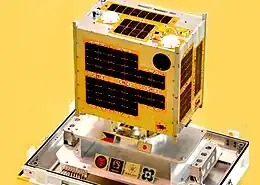| Program overview | |
|---|---|
| Country | Philippines / Japan |
| Organization | Department of Science and Technology University of the Philippines |
| Purpose | CubeSat development and operation / Local technology capability building |
| Status | Ongoing |
| Program history | |
| Duration | 2018– |
| Successes | 2 |
The Space Technology and Applications Mastery, Innovation and Advancement (abbreviated and stylized as STAMINA4Space) is a space technology program by the Philippine government.[1] It is considered as the successor program to the Philippine Scientific Earth Observation Microsatellite (PHL-Microsat) program, a cooperation between the Philippine government and Japanese universities to develop microsatellites.[2] The program is funded under the Department of Science and Technology.
It aims to use the results from the PHL-Microsat program to further research and develop small satellite technology capability in the country.[3]
STAMINA4Space Program officially succeeded the PHL-Microsat program in August 2018, inheriting two satellites, Diwata-1 and Diwata-2 and the CubeSat Maya-1.[4][5]
Sub-projects
The project is divided into five sub-projects.
| Project No. | Name | Abbreviation | Objective |
|---|---|---|---|
| 1 | Optical Payload Technology, In-depth Knowledge Acquisition, and Localization | OPTIKAL | Development of a scientific and operational optical payload primarily for agricultural monitoring.[6] |
| 2 | The Building PHL-50: Localizing the Diwata-1, 2 Bus System as the Country's Space Heritage 50 kg Microsatellite Bus | PHL-50 | Development of reference bus platform from Diwata-1 and Diwata-2.[7] |
| 3 | Space Science and Technology Proliferation through University Partnerships | STeP-UP | Derive learnings from the PHL-Microsat program and collaboration with the academe, industry players, and government agencies.[8] |
| 4 | Ground Receiving, Archiving, Science Product Development and Distribution | GRASPED | Systematic operations of the Diwata microsatellites[9] |
| 5 | Advanced Satellite Development and Know-How Transfer for the Philippines | ASP | Future planning of satellite missions and technology development projects for the Philippines' earth imaging needs. Assisting transition of such activities to the Philippine Space Agency.[10] |
STEP-UP Project
One of the four components of the STAMINA4Space Program is the Space Science and Technology Proliferation through University Partnerships (STEP-UP) Project. Under the program engineering students from the University of the Philippines who seeks to pursue a nanosatellite engineering track will learn how to build nanosatellites within the university's Diliman campus and have a cube satellite designed by themselves tested for space environment at the Kyushu Institute of Technology in Japan. The satellites will then be launched to the International Space Station for deployment and students will be trained on operating the satellites.[11]
A University Consortium on Space Science and Technology Applications is planned to be established within the STEP-UP Project and focus will be shifted to providing nanosatellite engineering scholarships and setting ground stations in within other universities in the country.[11]
Mission summary
| Designation | Launch | Deployment | End of mission | Summary | |||||
|---|---|---|---|---|---|---|---|---|---|
| Date | Site | Vehicle/Mission | Date | Site | Vehicle | Disposal | Date | ||
| Diwata-2 | October 29, 2018 | — | — | Replacement of Diwata-1 | |||||
| Maya-2 | February 21, 2021 | March 14, 2021 | ISS | — | Deorbited | July 5, 2022 | Replacement of Maya-1 | ||
| Maya-3[12] | August 29, 2021 | October 6, 2021 | ISS | — | Deorbited[13] | August 4, 2022 | |||
| Maya-4[12] | Deorbited[13] | August 8, 2022 | |||||||
| Maya-5[14] | June 5, 2023[15] | July 19, 2023 | ISS | — | — | ||||
| Maya-6[14] | |||||||||
| MULA | 2023 (planned) | Future satellite | |||||||
References
- ↑ "Diwata-2 takes flight". University of the Philippines. Retrieved October 31, 2018.
- ↑ "PHL's Diwata-2 microsatellite launched by Tanegashima Space Center". GMA News. October 29, 2018. Retrieved October 31, 2018.
- ↑ "DOST, UP announce local cube satellite development program". Medium. PHL-Microsat. October 18, 2018. Retrieved October 31, 2018.
- ↑ "PHL-Microsat: Timeline of Events". STAMINA4Space. Retrieved August 27, 2021.
- ↑ "Official statement on the "PHL-Microsat Program" being renamed as the "STAMINA4Space Program"". STAMINA4Space. February 14, 2019. Retrieved August 27, 2021.
- ↑ "Project 1: OPTIKAL". STAMINA4Space.
- ↑ "Project 2: PHL-50". STAMINA4Space. Retrieved August 27, 2021.
- ↑ "Project 3: STeP-UP". STAMINA4Space. Retrieved August 27, 2021.
- ↑ "Project 4: GRASPED". STAMINA4Space.
- ↑ "Project 5: ASP". STAMINA4Space. Retrieved August 27, 2021.
- 1 2 "With This UP Scholarship, You'll Learn How To Build A Cube Satellite". Flip Science. October 21, 2018. Retrieved October 31, 2018.
- 1 2 "Maya-3 and Maya-4". STAMINA4Space. Retrieved July 10, 2022.
- 1 2 "First Philippine University-built CubeSats Maya-3 and Maya-4 end their mission". STAMINA4Space. August 9, 2022. Retrieved August 18, 2022.
- 1 2 "Maya-5 and Maya-6". STAMINA4Space. Retrieved August 27, 2021.
- ↑ "Maya-5 and Maya-6 CubeSats launched to International Space Station". Philippine Space Agency (PhilSA). Retrieved June 5, 2023.
.jpg.webp)
